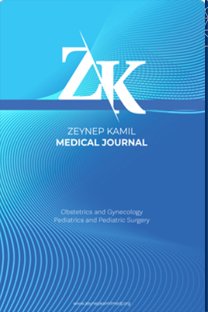Evaluation of voiding functions with the micturition video: The preliminary results
Evaluation of voiding functions with the micturition video: The preliminary results
___
- 1. Fowler CJ, Griffiths D, de Groat WC. The neural control of micturition. Nat Rev Neurosci 2008;9:453–66.
- 2. Kumar V, Dhabalia JV, Nelivigi GG, Punia MS, Suryavanshi M. Age, gender, and voided volume dependency of peak urinary flow rate and uroflowmetry nomogram in the Indian population. Indian J Urol 2009;25:461–6.
- 3. Ulu B, Demirbas M, Guler C, Samlı MM, Dinçel Ç. The effects of voided urine volumes on uroflowmetry parameters. Med J Kocattepe 2003;4:39–42.
- 4. Yağmur İ. Normal voiding curve. Turk J Pediatr Surg 2016;30:571–4.
- 5. Saleem MM. Digital imaging by parents: An aid to the diagnosis of ingui- nal hernia in infants and children. Singapore Med J 2008;49:145–6.
- 6. Kawaguchi AL, Shaul DB. Inguinal hernias can be accurately diagnosed using the parent’s digital photographs when the physical examination is nondiagnostic. J Pediatr Surg 2009;44:2327–9.
- 7. Rahlin M, Sarmiento B. Reliability of still photography measuring ha- bitual head deviation from midline in infants with congenital muscular torticollis. Pediatr Phys Ther 2010;22:399–406.
- 8. Kuiper RJ, de Jong JR, Kneepkens CM. There is something coming out of the anus of my child. Ned Tijdschr Geneeskd [Article in Dutch] 2011;155:A2735.
- 9. Akkoyun I, Akbiyik F, Soylu SG. The use of digital photos and video images taken by a parent in the diagnosis of anal swelling and anal protrusions in children with normal physical examination. J Pediatr Surg 2011;46:2132–4.
- ISSN: 1300-7971
- Yayın Aralığı: Yılda 4 Sayı
- Yayıncı: Ali Cangül
Serkan ORAL, Alper ŞİŞMANOĞLU, Yaşam Kemal AKPAK, Sebahattin ÇELİK, Nazan YURTÇU
Evaluation of voiding functions with the micturition video: The preliminary results
Tuğçe Merve ORBAY, Ayşenur CELAYİR, Cengiz GÜL, Bekir ERDEVE
Ayça ÖZGÜREL BOZKURT, Nazan USAL TARHAN, Enis ÖZKAYA
Halenur BOZDAĞ, Belgin DEVRANOĞLU, Esra AKDENİZ, Nazan YURTÇU, Nurullah PEKER
Fetal megacystis at 11–14 weeks of gestation: 3-year experience of a tertiary center
Gökhan BOLLUK, Özge ÖZDEMİR, Burak DEMİRDELEN
Evaluation of the relationship between dental caries and urinary tract infections
Fedli Emre KILIÇ, Habip ALMİŞ, İbrahim Hakan BUCAK, Mehmet TURGUT
Effect of COVID-19 on anesthesia preferences in cesarean section: An observational study
Meryem ONAY, Sema ŞANAL BAŞ, Ümit AKKEMİK, Ayten BİLİR
Nihan UYGUR KÜLCÜ, Züleyha Aysu SAY, Habibe AYVACI TAŞAN, Handan ÇETİNER, Zeynep Gamze KILIÇOĞLU
Surgical treatment of the rectal prolapse in children: A review
Cengiz GÜL, Sabri CANSARAN, Ayşenur CELAYİR
Kutlay GÜR, Nihan UYGUR KÜLCÜ, Özlem ERDEDE, Erdal SARI, Rabia Gönül SEZER YAMANEL, Abdulkadir BOZAYKUT
